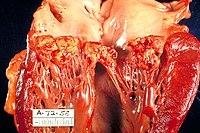
Photo from wikipedia
On physical examination, the patient was afebrile. Result of the cardiovascular examination was unremarkable. Consolidation or effusion was not observed on chest radiography. Electrocardiography showed diffuse ST elevation; hence, fibrinolytic… Click to show full abstract
On physical examination, the patient was afebrile. Result of the cardiovascular examination was unremarkable. Consolidation or effusion was not observed on chest radiography. Electrocardiography showed diffuse ST elevation; hence, fibrinolytic therapy was administered (Figure 1). Electrocardiography showed persistent ST elevation without dynamic ischemic changes. The patient’s C-reactive peptide level was high (408.8 mg/L). The ST elevation myocardial infarction had reverted to pericarditis. Nonsteroidal anti-inflammatory drug therapy was started but was later switched to high-dose aspirin due to acute kidney injury. Echocardiography revealed pericardial effusion with signs of tamponade (Figure 2). Pericardiocentesis was performed, and the pericardial fluid culture showed Salmonella enteritidis. Intravenous ceftriaxone was administered.
Journal Title: Revista da Sociedade Brasileira de Medicina Tropical
Year Published: 2022
Link to full text (if available)
Share on Social Media: Sign Up to like & get
recommendations!